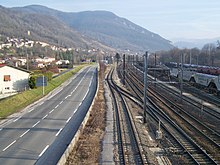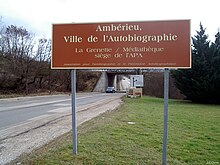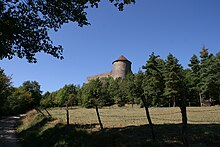|
Ambérieu-en-Bugey
Ambérieu-en-Bugey (French pronunciation: [ɑ̃beʁjø ɑ̃ byʒɛ, byʒe] ⓘ; Arpitan: Ambèriô) is a commune in the Ain department, Auvergne-Rhône-Alpes region, France. With 14,288 inhabitants (2020), it is one of the largest towns of the historical region of Bugey.[3] It is the largest town in the arrondissement of Belley and the seat of the canton of Ambérieu-en-Bugey which consists of 18 communes. Its urban area has 17,301 inhabitants (2020).[3] The town was officially simply called Ambérieu until 31 March 1955 when it became Ambérieu-en-Bugey. The town is known for being an important railway junction (around Ambérieu station), but also for winning the Croix de guerre 1939-1945 with citation at the Liberation. GeographyLocationAmbérieu-en-Bugey is 50 km northeast of Lyon, 30 km[4] south of Bourg-en-Bresse, 73 km northwest of Aix-les-Bains, 76 km southeast of Mâcon and 104 km west of Geneva, Switzerland. The town is in the commune's western part, on the right bank of the river Albarine, which forms most of the commune's southern border. It is surrounded by the communes of Saint-Denis-en-Bugey, and Bettant. Its expansion is due to demographic expansion with two new housing areas on the eastern side of the town where there is plenty of land (near Bettant). Ambérieu-en-Bugey is located at the foot of the western foothills of the Jura mountains of Bugey and opens onto the plain of Ain at the mouth of the gorge of Albarine. ClimateAmbérieu features an "oceanic climate" (Cfb) under the Köppen system. However, the city contains significant seasonal differences between the warm to hot summers and the cool to cold winters. Both temperatures above 30 °C (86 °F) for the summer months and winter air frosts are common. Its record low of −26.9 °C (−16.4 °F) decisively indicates its continental influence, as well as its record high of 40.3 °C (104.5 °F).
Weather Data for Ambérieu-en-Bugey
Topography and geologyThe commune[9] is at an altitude between 237 m and 753 m. The sub-soil has been an important economic activity in the Ambérieu region in the 19th century until the first half of the 20th century. For example, the extraction of lignite (used in particular for heating) was an important activity in Ambérieu during the First World War.[10] Ambérieu-en-Bugey reflects the characteristics of Bugey in geological terms: the region is composed of a folded mountain relief, partly karstified, which is the southern extension of the Jura mountains. The dating of the limestone of Bugey is between the Jurassic (for the anticlines) and the Cretaceous (for the synclines). The folds are easily visible in outcrops and cliffs.[11] HydrographyThere are several rivers in Ambérieu-en-Bugey. Besides the Albarine which flows through Ambérieu-en-Bugey,[12] two streams which are themselves tributaries of the Albarine flow into the commune: the Seymard (15.5 km long[13] and the Foulon[14] (3.4 km long). Channels of communication and transportRail Here can be seen the station.   Ambérieu station is located at the junction of the Mâcon-Ambérieu line and the Lyon-Geneva line and is served by many TER trains to Lyon, Bourg-en-Bresse, Mâcon, Dijon, Besançon, Strasbourg, Culoz, Geneva, Aix-les-Bains, and Chambery. Railway historyThe railway has served the commune since 1856,[15] making the town an important railway junction and the railway station, "one of the largest connection centres in France".[15] Some lines which are now extinct (e.g. the Ambérieu-Montalieu-Vercieu line) created a great deal of rail activity at Ambérieu-en-Bugey; these activities have been illustrated in the collections of the Railway Museum since 1987. In the 1930s the railway junction, sometimes called the "Ambérieu Star" had 247 locomotives stationed at the depot. The town then had about 6,500 inhabitants and the compagnie des chemins de fer de Paris à Lyon et à la Méditerranée employed about 2,150 railway workers.[16] On 7 June 1944 an operation was organized by resistance railway workers and maquisards to disable 52 locomotives and much other equipment. This action reduced the capacity of this strategic site and reduced the communications of the German army so avoiding bombing by the Allies on the site.[17] A monument near the Ambérieu-en-Bugey station recalls this feat of arms. Air transport Aerial activity has been present in Ambérieu-en-Bugey since the beginning of the 20th century. For example, Antoine de Saint-Exupéry made his first flight in July 1912 at the civil aerodrome of Bellievre.[18] Ambérieu-en-Bugey Air Base was built during the Second World War as a temporary airfield by the United States Air Force XII Engineer Command in August 1944. Named the "Colonel Chambonnet Base", today it is a supply and repair centre for electronic equipment aboard aircraft, ground communications detection equipment, navigation aids, and a manufacturing centre for simple equipment. There is also a civilian aerodrome near Ambérieu-en-Bugey called the Ambérieu aerodrome but it is located in the neighbouring communes of Château-Gaillard and Ambronay. Air historyMany flight schools have been located at Ambérieu-en-Bugey: the Bressane Aviation School, founded in 1909 by Mignot and Harding, which was associated with the Société Aérienne de Lyon-Bron. In 1912 it took the name Deperdussin-SPAD and was directed by the pilot René Vidart. There is also the Louis-Mouthier flight school which was opened in 1911. In 1915 the Military flight school of Ambérieu was established. Finally, in 1928, the Caudron flight school moved from Le Crotoy in the Somme to Ambérieu-en-Bugey. This school trained Jean Mermoz and René Fonck. Road transportThe commune is traversed by the A42 autoroute. The exit for the commune is: No. 8 Ambérieu-en-Bugey in the direction of Geneva. In addition, several departmental roads serve the commune: the D1075 (formerly National Highway 75) which connects Bourg-en-Bresse to Sisteron, the D1504 (the old national road 504) which connects Ambérieu-en-Bugey to the commune of Le Bourget-du-Lac, and the D904 (the old road known as the "Valley of the Saone"). In 2017 there were 6,403 households in Ambérieu-en-Bugey; 84.8% of households owned at least one car and 31.8% of all households had at least two cars.[19] BusesSince 4 January 2010, a network of three bus lines has been established to replace the Ambar'bus service. The new network is called TAM (Transport Network Ambarrois) and links its timetables to the schedules of TER Auvergne-Rhône-Alpes. The network operates from 5:40 a.m. to 8:46 p.m. and carries 208 passengers per day.[20] HousingIn 2017 the total number of dwellings in the municipality was 7,217 (against 5,949 in 2007). Among these units, 88.7% were primary residences, second homes 1.7%, and 9.6% were vacant housing.[19] These units were split between 42.9% houses and 56.7% apartments. The proportion of residents owning their own homes was 42.7%.[19] Toponymy Ambérieu is mentioned in the form Ambariacus in 843 then Ambayreu in 1240.[21] The second element -acus represents a suffix of Gallic origin *-āko(n) which is usually written as acum in Latin. This is a locative suffix which later will designate villae in Gallo-Roman. It has generally evolved phonetically as -ieu in the region. The first element designates the Gauls ( Celtic people ) of Ambarri whose name meant "living on both (*amb) sides of the Saone (Arar, the Saône)" or was a Gallic anthroponym Ambarrius. Ambérieux-en-Dombes, Ambérieux, Ambérac, and Ambeyrac are similar topographical formations. HistoryAntiquityA number of archaeological discoveries relating to antiquity have been made in Ambérieu-en-Bugey:[22]
Middle AgesIn the Middle Ages Ambérieu belonged to Bugey which, like Vaud, was acquired by Amadeus VI of Savoy, after signing the Treaty of Paris with France in 1355 which set the limits of the Duchy of Savoy and the Dauphiné. The city lay on the line of defence against France of the Duchy of Savoy. A series of fortifications were built to protect Savoy. Allymes Castle, the fortification of Brédevent, the Saint-Germain Castle, and the tower of Saint-Denis were parts of this line of defence in the Bugey possessions of the Duke of Savoy. Pérouges, a city of Savoy located on the plains played a commercial role at the border with France until the Treaty of Lyon. RenaissanceRelated article: Treaty of Lyon (1601). On 17 January 1601 the Treaty of Lyon rejoined Bugey and therefore Ambérieu to France. This treaty between the Duke Charles Emmanuel I of Savoy and King Henry IV of France also unified France with Bresse, Bugey (at the time explicitly distinguished from Valromey), and the Pays de Gex. World War IIMarcel Demia and the Resistance of AinIn late 1941 Henri Romans-Petit was engaged in the French Hope network in Saint-Etienne. During Christmas an independent resistance fighter, Marcel Demia a Market gardener and Horticulturalist from the Ambérieu-en-Bugey commune went there to visit his parents. The two men meet and exchanged views on the situation. Their shared commitment motivated Henri Romans-Petit to create a Resistance organization in the department of Ain.[24] Marcel Demia spoke of some young resistance fighters who he placed on isolated farms and the difficulties encountered in his organization. Henri Romans-Petit arrived in Ain in 1942[25] and began to help the resistance fighters of the STO and his host. Ambérieu-en-Bugey today has a street called Marcel Demia. Liberation of the townThe town was liberated on 3 September 1944 by troops who landed in Provence.[26] Known for the actions of its resistance, particularly from the Maquis de l'Ain et du Haut-Jura the town was nicknamed "The Rebel Ambérieu" and was decorated with the Croix de guerre 1939-1945 with citation. New nameOn 31 March 1955 Ambérieu was renamed Ambérieu-en-Bugey. Heraldry
Politics and administrationThe town has between 10,000 and 20,000 inhabitants and the town council is composed of 33 members: the mayor, nine deputies, and 23 councilors.[28] Since 2014, Daniel Fabre has been the mayor of Ambérieu-en-Bugey. He was re-elected in the 2020 municipal elections for the 2020-2026 tenure.[1] List of Successive Mayors of Ambérieu-en-Bugey[29]
Political environmentThe commune, at the instigation of Saint-Vulbas and Pérouges has been experimenting with a weed control plan that does not involve the use of chemicals[31] Air qualityAn integral part of the Community of communes of the plain of Ain, Ambérieu-en-Bugey commune participates in actions such as air quality control as quality is potentially undermined by the proximity of the industrial park of the Plain of Ain.[32] Shale gasThe geological sub-structure of the Ambérieu-en-Bugey region contains Shale gas. The potential exploitation of these deposits has caused some hostility which has been expressed in local politics. Advocacy undertaken by opposition movements are varied: broadcasts,[33][34] a documentary called Gasland - in June 2011, and demonstrations[35] at Blyes the main town in the region concerned. Twin towns – sister citiesAmbérieu-en-Bugey is twinned with:[36]
Population and societyPopulationIts inhabitants are known as Ambarrois (masculine) and Ambarroises (feminine) in French.[37]
Distribution of age groupsThe population of the town is slightly younger than the departmental average. Percentage distribution of age groups in Ambérieu-en-Bugey and Ain Department in 2017
EducationPublic educationAmbérieu-en-Bugey is located in the Academy of Lyon area. The town administers several kindergartens and communal elementary schools.
Private educationThe Sainte-Marie school brings together a kindergarten, a primary school, and a college. Other educationA GRETA - an organization specialising in continuing education for adults - is based in Ambérieu-en-Bugey. A Bernard Palissy training centre for apprentices is also based in the commune. Cultural events and festivals  In addition to the railway, as shown by the creation of the Railway Museum railway in 1987, Ambérieu-en-Bugey also developed around its library with an interest in autobiographical heritage including hosting the headquarters of the Association For Autobiography (APA). In addition, the town has provided a house for associations. There have been two notable events in the town: The first, the festival Jazz in the Park was a festival of jazz that took place in the Parc des Échelles in July. The 13th and last edition was held in 2006. The second, the Salon du Gourmet is held each year in November with dozens of exhibitors from all over France to show their crafts. The Association for autobiography and autobiographical heritage located in Ambérieu-en-Bugey also organizes ad hoc cultural events. HealthSeveral medical centres are based in Ambérieu-en-Bugey: other than the mutual clinic there is a maternity unit in the town, a medical practice at Allymes, the Paul-Mourlon centre for early medico-social action, and the specialized home care service also named Paul-Mourlon. SportsInfrastructureThe town has several sports facilities: the Cordier, Bellievre, Saint-Exupéry, and Plaine de l'Ain gyms. There is also a nautical centre called Laure Manaudou, the Theo-Tillier[Note 4] stadium, and the skatepark.
MediaPrinting pressThe newspaper le Progrès offers a daily edition dedicated to the region of Bugey. Voix de l'Ain is a weekly publication offering local information for different regions of the department. Le Journal du Bugey is a weekly publication more focused on information for the Ambérieu-en-Bugey area and its surroundings. TVFrance 3 Rhône-Alpes Auvergne' is available in the region. RadioA local radio station broadcasts the Fréquence Côtière[42] from Montluel. Since the 2000s, the name has evolved into the station FC radio, the essential. ReligionCatholic worshipThere are six churches for Catholic worship in the parish of Ambérieu-en-Bugey: Saint Symphorien, Saint Jean-Marie Vianney, Notre Dame des Neiges, Sainte Foy, Saint Maurice, and Saint Denis.[43] This parish is in the parish grouping of "Ambérieu-en-Bugey" which depends on the diocese of Belley-Ars in the Archdiocese of Lyon.[44] Protestant worshipAn evangelical Protestant church is located at 31 rue de la Resistance. Muslim worshipTwo prayer halls of the Muslim Faith[45] are located in Ambérieu-en-Bugey: the first is for the Union of Maghreb people of Ain and is located on the rue de la Resistance. The second is run by the Union of Muslim Associations for the Lyon Area and is located on Avenue Paul Painlevé. A building permit has been approved by the town council to build a mosque[46] Freemasonry A Masonic lodge, the Brotherhood bugeysienne is based in Ambérieu-en-Bugey. They also have a Masonic temple in the commune of Saint-Denis-en-Bugey. It is affiliated to the Grand Orient of France. EconomyIncomes of the population and taxIn 2017 according to the INSEE survey, the median net income per household was €19,860 per year. 49% of the commune's households were then taxable.[19] EmploymentIn 2017 the population of Ambérieu-en-Bugey aged between 15 and 64 was distributed as follows: 76.2% of active people, 11.3% unemployed, 9.5% student or trainee, and 6.1% of retirees.[19] An employment centre is located in the town.
Businesses and shopsAt 31 December 2015, Ambérieu-en-Bugey had 1,337 business establishments: 52 were specialized in industrial activity, 131 in construction, 907 in trade, 7 in agriculture, and 142 were in public administration, education, health and social work.[19] In 2018, 114 new companies were established in the territory of which 80 are under the auto-entrepreneur rules.[19] Culture and heritage  Civil monumentsThere are three sites in the commune that are registered as historical monuments:

Religious monuments
Environmental heritageThe commune has several parks:
Ambérieu-en-Bugey was awarded one flower in the Concours des villes et villages fleuris (Competition for Towns and Villages in bloom) competition in 2005 and second in 2008. In 2014 the commune was awarded two flowers.[52] In popular cultureSeveral films were partially shot in Ambérieu-en-Bugey:
Notable people
Gallery
See alsoBibliography
External links
Notes and referencesNotes
References
Wikimedia Commons has media related to Ambérieu-en-Bugey. |
||||||||||||||||||||||||||||||||||||||||||||||||||||||||||||||||||||||||||||||||||||||||||||||||||||||||||||||||||||||||||||||||||||||||||||||||||||||||||||||||||||||||||||||||||||||||||||||||||||||||||||||||||||||||||||||||||||||||||||||||||||||||||||||||||||||||||||||||||||||||||||||||||||||||||||||||||||||||||||||||||||||||||||||||||||||||||||||||||||||||||||||||||||||||||||||||||||||||||||||||||||||||||||||||||||||||||||||||||||||||||||||||||||||||||||||||||||||||||||||||||||||||||||||||||||||||||||||||||||||||||||||||||||||||||||||||||||||||||||||||||||||||||||||












